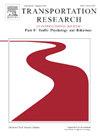How different levels of semantic segmentation affect human perception of driving scenes
IF 3.5
2区 工程技术
Q1 PSYCHOLOGY, APPLIED
Transportation Research Part F-Traffic Psychology and Behaviour
Pub Date : 2025-02-01
DOI:10.1016/j.trf.2024.11.024
引用次数: 0
Abstract
As automated vehicles continue to advance, teleoperation has emerged as a critical support system for navigating complex and unpredictable environments that exceed the vehicles' current autonomous capabilities. A main issue in the implementation of teleoperation is latency caused by the high bandwidth required to transmit the video feed from the vehicle to the remote teleoperation station. A possible approach for addressing the latency problem is the transfer of lower-resolution or compressed videos between the vehicle and the teleoperation station. When applying semantic segmentation on the video feed, many pixels are mapped to a limited set of possible colors according to the types of objects that they represent. This concept has been commonly used in autonomous driving algorithms and has the potential to enable the transferring of smaller-sized videos thus reducing bandwidth. In this study, we examine how presenting semantically segmented driving scenes to humans affects their perception of the scene, and specifically, how it affects their hazard perception and situation awareness. We conducted two user studies comparing the effects of using different levels and types of semantic segmentation. Our results indicate that viewing partly segmented scenes, such that only a selected set of object types are colored, commonly achieves the same effect, and sometimes even outperforms a realistic view. Our study and its insights may pave the way for future research, development, and design of teleoperation systems of automated vehicles.
不同层次的语义分割如何影响人类对驾驶场景的感知
随着自动驾驶汽车的不断发展,远程操作已经成为一种关键的支持系统,用于导航复杂和不可预测的环境,这些环境超出了汽车目前的自主能力。远程操作实现中的一个主要问题是由于将视频馈送从车辆传输到远程远程操作站所需的高带宽引起的延迟。解决延迟问题的一种可能方法是在车辆和远程操作站之间传输低分辨率或压缩视频。当在视频提要上应用语义分割时,根据它们所代表的对象类型,许多像素被映射到一组有限的可能颜色。这一概念已被广泛用于自动驾驶算法,并有可能实现较小尺寸视频的传输,从而减少带宽。在本研究中,我们研究了向人类呈现语义分段的驾驶场景如何影响他们对场景的感知,特别是如何影响他们的危险感知和情境意识。我们进行了两项用户研究,比较了使用不同级别和类型的语义分割的效果。我们的结果表明,观看部分分割的场景,例如只有一组选定的对象类型被着色,通常可以达到相同的效果,有时甚至优于现实视图。我们的研究及其见解可能为未来自动驾驶汽车远程操作系统的研究、开发和设计铺平道路。
本文章由计算机程序翻译,如有差异,请以英文原文为准。
求助全文
约1分钟内获得全文
求助全文
来源期刊
CiteScore
7.60
自引率
14.60%
发文量
239
审稿时长
71 days
期刊介绍:
Transportation Research Part F: Traffic Psychology and Behaviour focuses on the behavioural and psychological aspects of traffic and transport. The aim of the journal is to enhance theory development, improve the quality of empirical studies and to stimulate the application of research findings in practice. TRF provides a focus and a means of communication for the considerable amount of research activities that are now being carried out in this field. The journal provides a forum for transportation researchers, psychologists, ergonomists, engineers and policy-makers with an interest in traffic and transport psychology.

 求助内容:
求助内容: 应助结果提醒方式:
应助结果提醒方式:


